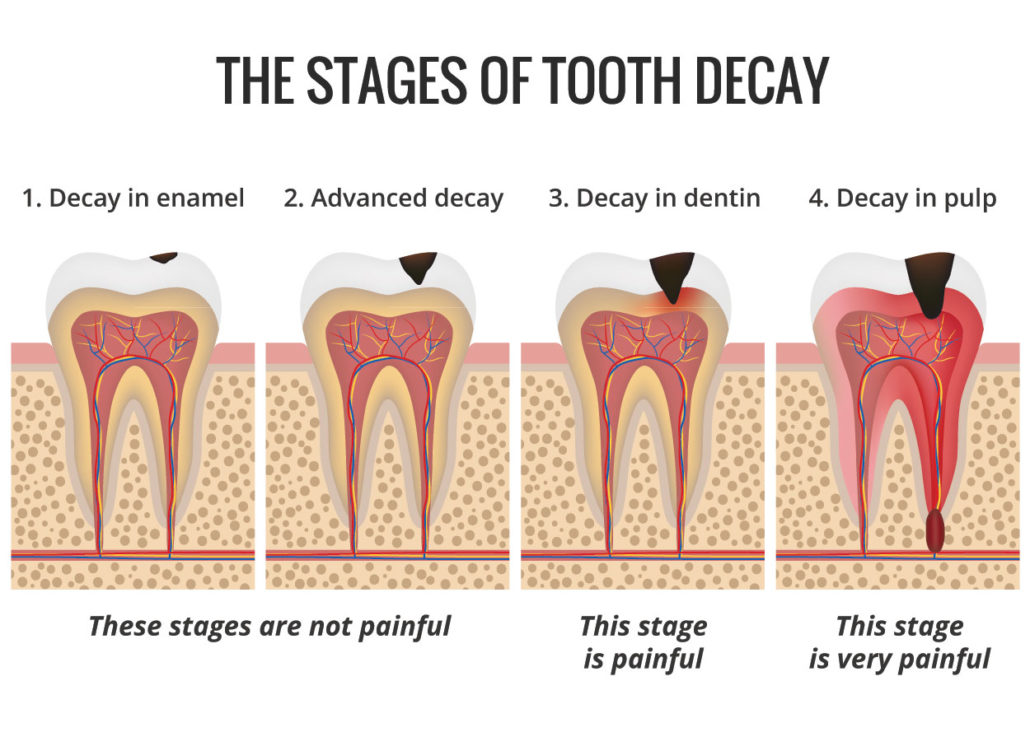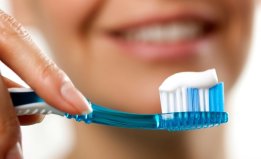Tooth decay is the deterioration of the outer layer of your teeth called the enamel. It is the stage that precedes development of a full cavity. Tooth decay are especially prevalent in children, teens, and seniors. Over 90% of Australian adults have some form of tooth decay in their permanent teeth.
It is the most widespread chronic disease in Australia whilst simultaneously being the most preventable. If left untreated, tooth decay can spread to deeper layers of the tooth and lead to tooth ache, infection, and potential tooth loss.
Fortunately, most forms of tooth decay are completely preventable with the establishment of a good oral hygiene routine and some lifestyle considerations.
Causes of tooth decay
Our mouths are filled with bacteria, most of which are good. However, some can be harmful especially if given the right conditions. These bacteria are stuck onto our teeth through a film called plaque, which is removed when we brush our teeth.
The main cause of tooth decay is the acid produced from those bad bacteria metabolizing sugar. This acid is what takes away the minerals in our teeth, leading to the tooth eroding and weakening. If left untreated, the initial decay can lead to the development of a full cavity which would require professional restoration.
Thus, frequent exposure to sugary, starchy, and/or acidic food and drinks (ex. Soft drinks, fruit juices) feeds these bacteria and promotes the development of tooth decay. Other lifestyle factors including regular smoking and drinking can also change the acidity in your mouth and promote the growth of these bad bacteria. Excessive plaque buildup can also lead to the bad bacteria dominating which promotes more acid production and gum disease.
Stages of tooth decay
The first visible stage of tooth decay isn’t as obvious as most people think! The common image many people have of tooth decay include seeing dark spots and holes on the teeth. However, those are all signs of late stage tooth decay.
The earliest sign of tooth decay appears as a matte white spot on your tooth. This area represents where minerals have been lost. If this is seen, the decay is still in a reversible state, and no surgical intervention is needed! The enamel can repair itself if given the right conditions such as decreasing sugar intake and undergoing a proper oral hygiene. Additional products like tooth mousse can also help provide additional minerals needed for your enamel to naturally repair itself.
If tooth decay progresses past the white spot appearance, the tooth can start to look dark. This means that the decay has reached the inner layer below the enamel, called dentine. This layer is what supports the enamel and prevents it from cracking. Non-surgical repairing of the tooth can still occur through use of specialized products that help re-strengthen the enamel. Repairs will take longer than the white spot stage.
The last stage of tooth decay is full cavitation. This means that the dentine has become so decayed, that it can’t support the enamel anymore, leading to the enamel collapsing and causing a hole in the tooth. At this point, the damage is permanent, and a dentist must repair the tooth with a filling. In more severe cases, a root canal may be needed.

Symptoms of tooth decay
Early stages of tooth decay often don’t have symptoms. However, if left untreated and allowed to develop, tooth decay can lead to more severe symptoms including tooth pain, tooth sensitivity, and facial swelling.
How to prevent tooth decay
The number one cause of tooth decay is excessive dietary sugar in combination with a poor oral hygiene routine. Good oral hygiene, some lifestyle changes, and professional treatments can avoid the development of cavities and tooth decay:
Oral hygiene tips
Brushing with fluoride tooth paste twice a day (morning and night)
Brushing your teeth with fluoride-containing toothpaste twice a day is one of the most effective methods in preventing cavities. It physically removes any lingering sugars, acid, or food trapped in teeth, which all promote the growth of bad bacteria. Brushing also prevents excessive plaque buildup which houses those bad bacteria. Fluoride is an important element in promoting enamel repair and can significantly decrease risk of cavity development.
It is important to note that overbrushing can also cause damage to the enamel and lead to tooth decay. An acidic meal/drink temporarily softens your enamel. Thus, brushing it in this state would rub away the surface layer of your tooth. Instead, simply rinse your mouth with water, mouthwash, or even milk.
Flossing regularly (daily)
Flossing regularly prevents excessive plaque buildup between teeth where toothbrushing may not reach. It also stimulates your gums and further prevents the development of gum disease.
Rinsing with fluoride-containing mouthwashes
Many mouthwashes contain fluoride and other compounds that help promote the strengthening of enamel. A quick rinse after a meal or drink can also restore the acidity in your mouth back to normal without overbrushing (see brushing).
Lifestyle tips
Drink tap water
Most public water supplies now contain a small amount of fluoride which helps with strengthening your teeth. Frequent exposure to fluoridated tap water will significantly reduce the risk of tooth decay.
Decrease dietary sugar intake
As previously mentioned, excessive dietary sugar is the number one cause of tooth decay. Decreasing the amount of consumed sugar will prevent the bad bacteria from producing acid and destroying enamel.
Avoid frequent snacking and sipping on sugary/acidic drinks
Slowly sipping on a can of soda throughout the day is worse for your teeth than drinking the can all in one go. In other words, decreasing the frequency of sugar in comparison to the amount of sugar has a larger effect in decreasing tooth decay.
This is because whenever your mouth bacteria are exposed to sugar, they will produce a bit of acid. Your body can restore the acidity of your mouth naturally, but it takes a bit of time. If the bacteria have constant sugar exposure, there is continuous acid production and your mouth cannot restore the acidity fast enough, leading to your teeth being continuously attacked.
Chew sugar-free gum
Chewing gum stimulates your saliva which will help clear away some lingering sugars and food particles in your mouth. Like brushing, it can also physically remove any loose bacteria.
Eat cheese or drink milk
Dairy products are great for restoring the acidity in your mouth after a meal or drink, and thus can reduce the risk of tooth decay. Cheese is particularly good because it has the added effect of chewing which will stimulate saliva flow and removal of some bacteria. Dairy products also have a protein that helps with retaining minerals that help repair and strengthen enamel.
Professional preventative options
Dental sealants
The most common area for food to get stuck is in the crevices (called fissures) on your back most teeth (molars). Stuck food can provide nutrients for the bad bacteria to grow and cause tooth decay. Dentists can apply a compound that fills those crevices which makes it harder for food particles to get stuck there.
Regular check ups
Seeing your dentist regularly may catch any potential tooth decay early in its development. Early diagnosis of tooth decay allows you to take actions to allow your tooth to repair naturally and avoid invasive treatments that may potentially be costly.
Tooth Decay Treatments
There are several options available to treat tooth decay depending on the stage and severity of the decay:
Fluoride treatments (varnish or tray)
If the tooth decay is diagnosed early enough (ex. white spot), fluoride treatments can help the enamel naturally repair itself and there is no need for surgical intervention. This can include the placement of a fluoride varnish, which is a polish your dentist applies to your teeth that is dense with fluoride, promoting the natural repair of the enamel. Additionally, fluoride trays can also be given; your dentist provides you with a fluoride gel that you apply onto a tray specially made to fit your teeth, which you wear to promote enamel repair.
Fillings
If the tooth decay has progressed to a cavity, then your dentist must apply a filling to restore the tooth. They will remove any decayed tooth tissue and then use a filling material to fill up the hole.
Root canal
If the tooth decay has spread into the inside of the tooth (pulp), you may need a root canal. This involves your dentist surgically going into the deep layers of the tooth and removing any decayed tooth tissue. They will then use a filling material to fill the teeth, or in some severe cases, a new crown (top of the tooth) is made and placed on top.
Extraction (pulling the tooth out)
In the most severe case of tooth decay and the entire tooth is unable to be repaired, then your dentist must completely remove the tooth. After a tooth extraction, there are a variety of options to replace the previous tooth with a false tooth including a bridge or implant.






